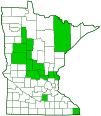forked campion
(Silene dichotoma)
Conservation • Description • Habitat • Ecology • Use • Distribution • Taxonomy
Conservation Status |
|
|||||||
| IUCN Red List | not listed |
|||||||
| NatureServe | NNA - Not applicable SNA - Not applicable |
|||||||
| Minnesota | not listed |
|||||||
Description |
||
Forked campion is a 12″ to 36″ tall, erect, annual forb that rises from a robust, slender taproot. When young the plant forms a basal rosette of leaves. Later it sends up flowering stems. The stems are erect and branched near the top. The stems are usually reddish and rough with firm, stiff hairs. There are up to 10 pairs of leaves on the stem. Basal leaves are broad, lance-shaped to spatula-shaped, 1⅛″ to 4″ long (including the leaf stalk), and ¼″ to 1⅛″ wide, hairy, and on leaf stalks. The leaf stalk is as long as the leaf blade. Stem leaves are smaller, narrower, and opposite. They are lance-shaped, ⅔″ to 2″ long, ⅛″ to ⅔″ wide. They become progressively smaller as they ascend the stem. The lower leaves are on short leaf stalks, the upper leaves are attached to the stem without a stalk. They taper gradually to a pointed tip with straight sides along the tip. The base is wedge shaped, narrowly triangular and tapering to a point. The upper and lower surfaces are rough with firm, stiff hairs. The margins are untoothed. The inflorescence is open, long, many-branched clusters with many flowers. The flowers are about ⅝″ wide when fully open. They are attached perpendicularly to the stem without a stalk. The sepals are fused at the base into a narrow tube (calyx) terminating in 5 short lobes. The calyx is ⅓″ to ⅔″ long, about ⅛″ wide, and densely covered with firm, stiff hairs. It is not inflated. It has 10 major veins that are raised on the surface (prominent), forming ridges. The petals are white, rarely pink, deeply two-lobed, horizontally spreading, with a stalk-like narrow base (claw). The flower has 10 stamens, which are longer than the petals, and 3 styles, which are twice as long as the calyx. The fruit is an ellipsoid capsule with 6 spreading teeth at the top. |
||
Height |
||
12″ to 36″ |
||
Flower Color |
||
White, rarely pink |
||
Similar Species |
||
The deeply-lobed petals and the flowers attached perpendicular to the stem without a leaf stalk are distinguishing features of this plant. |
||
Habitat |
||
Cultivated land, roadsides, burnt clearings in forests, disturbed sites. |
||
Ecology |
||
Flowering |
||
June to October |
||
Pests and Diseases |
||
|
||
Use |
||
|
||
Distribution |
||||
|
Sources |
|||
| 4/21/2023 | ||||
Nativity |
||||
Native to Asia and Europe. Introduced and naturalized in the United States. |
||||
Occurrence |
||||
|
||||
Taxonomy |
|||
| Kingdom | Plantae (green algae and land plants) | ||
| Subkingdom | Viridiplantae (green plants) | ||
| Infrakingdom | Streptophyta (land plants and green algae) | ||
| Superdivision | Embryophyta (land plants) | ||
| Division | Tracheophyta (vascular plants) | ||
| Subdivision | Spermatophytina (seed plants) | ||
| Class | Magnoliopsida (flowering plants) | ||
| Subclass | Caryophyllidae | ||
| Superorder | Caryophyllanae | ||
Order |
Caryophyllales (pinks, cactuses, and allies) | ||
Family |
Caryophyllaceae (pink) | ||
| Subfamily | Caryophylloideae | ||
| Tribe | Sileneae | ||
Genus |
Silene (catchflies) | ||
| Subgenus | Behenantha | ||
| Section | Dichotomae | ||
Subordinate Taxa |
|||
|
|||
Synonyms |
|||
|
|||
Common Names |
|||
dichotoma silene forked campion forking campion |
|||
Glossary
Calyx
The flower cup. May be the group of outer floral leaves (sepals) collectively, or a tube with lobes.
Claw
A stalk-like narrowed base of some petals and sepals.
Sepal
An outer floral leaf, usually green but sometimes colored, at the base of a flower.
Visitor Photos |
|||||
Share your photo of this plant. |
|||||
| This button not working for you? Simply email us at info@MinnesotaSeasons.com. Attach one or more photos and, if you like, a caption. |
|||||
|
|||||
MinnesotaSeasons.com Photos |
|||||
|
|||||

Slideshows |
||

Visitor Videos |
|||
Share your video of this plant. |
|||
| This button not working for you? Simply email us at info@MinnesotaSeasons.com. Attach a video, a YouTube link, or a cloud storage link. |
|||
Other Videos |
|||

Visitor Sightings |
|||||
Report a sighting of this plant. |
|||||
| This button not working for you? Simply email us at info@MinnesotaSeasons.com. Be sure to include a location. |
|||||
|
|||||
MinnesotaSeasons.com Sightings |
|||||
|
|||||

|
Created: Last Updated: © MinnesotaSeasons.com. All rights reserved. |
